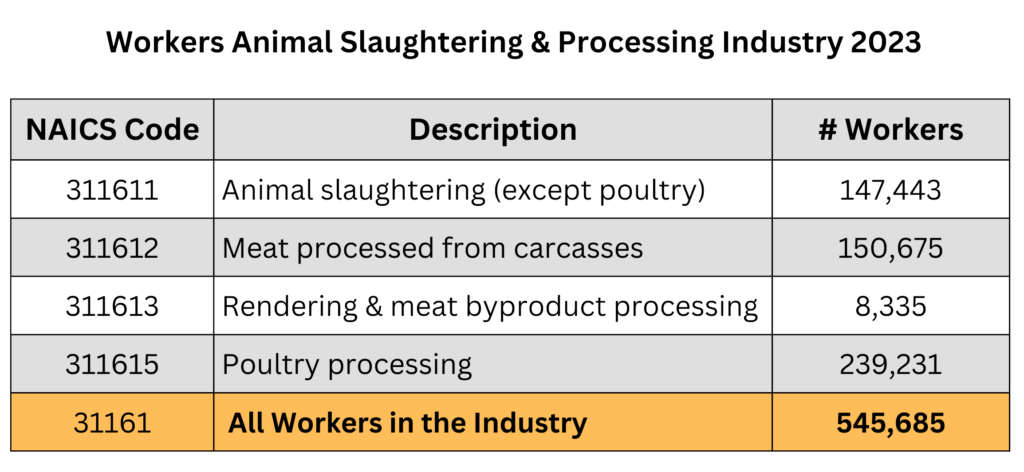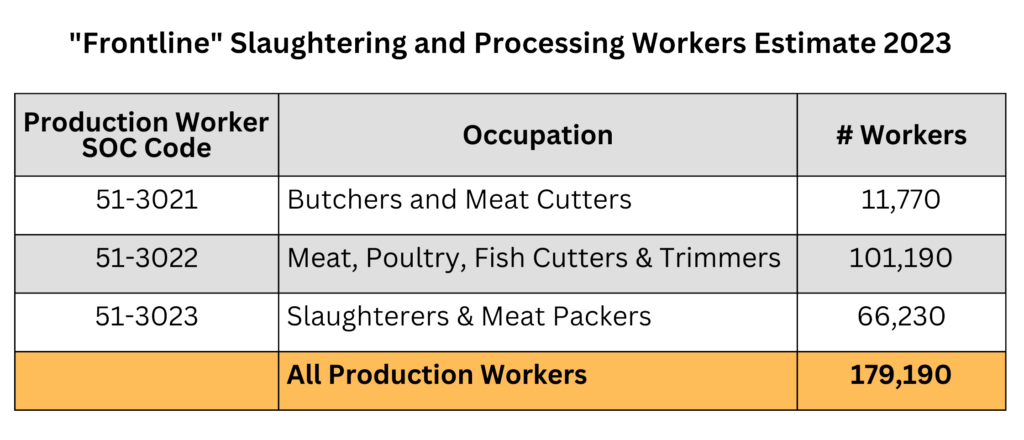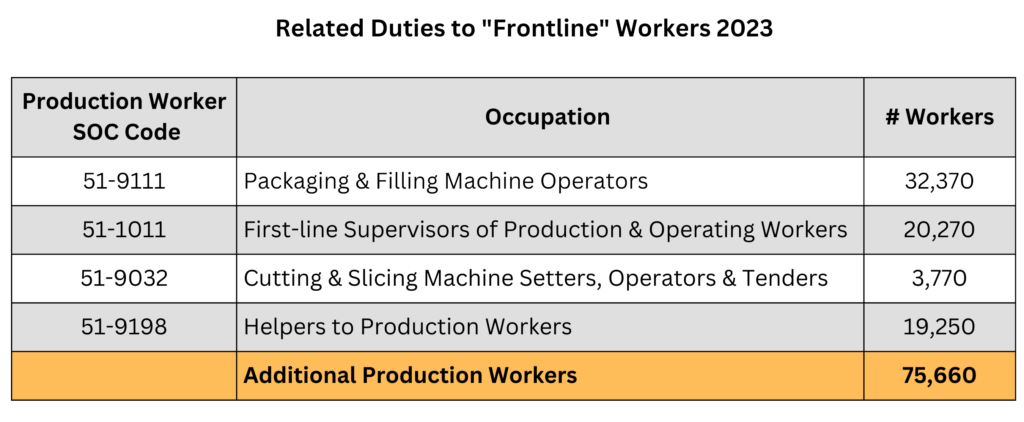In 2023, the Bureau of Labor Statistics (BLS) reports there were a total of 545,882 people employed in the entire “animal slaughtering and processing” industry in the U.S. This is ~3% increase from 2022 when there were 530,470 workers.[1]
This figure from the BLS is based on the North American Industry Classification System (NAICS) which classifies business establishments by their primary activity or production process. The NAICS uses “a production-oriented conceptual framework to group establishments into industries based on the activity in which they are primarily engaged.”[2] Thus, in addition to workers engaged in the actual handling of meat or poultry, it would include personnel from administration, marketing, transportation, sanitation, etc.
There were ~131 million workers in all U.S. industries in 2023. Those in the animal slaughter and processing sector make up close to one in ~240 industry workers.[3]
U.S. Bureau of Labor Statistics, Quarterly Census of Employment and Wages, Private, NAICS 31161 Animal slaughtering and processing, All States 2023 Annual Averages.
U.S. Bureau of Labor Statistics (2023) North American Industry Classification System (NAICS) at BLS https://www.bls.gov/bls/naics.htm
U.S. Bureau of Labor Statistics, Quarterly Census of Employment and Wages, All industries U.S. total 2023 [131,289,681]
The Bureau of Labor Statistics breaks down the “animal slaughtering and processing” industry into four categories:[1]

This includes workers in all positions within these industry categories.
U.S. Bureau of Labor Statistics QCEW Employment and Wages Data Viewer [as of August, 2024] https://data.bls.gov/cew/apps/data_views/data_views.htm#tab=Tables
In addition to the NAICS industry classification, the BLS uses the Standard Occupational Classification System (SOC) to categorize workers based on their job duties with respect to the work performed and their skills. These are organized in sub-sets of the industry classifications.
As a sub-set of the “Animal Slaughtering and Processing” industry (NAICS 311600), the BLS estimates that in 2023 there were 324,560 workers in “production occupations.”[1] The majority of these occupations are meat, poultry, and fish processing workers, slaughterers and meat packers (see, question below).

Along with groups like meat processors, production workers also include supervisors, packaging operators, machine operators, and equipment operators to name just a few occupational categories listed.
U.S. Bureau of Labor of Labor Statistics, May 2023 National Industry-Specific Occupational Employment and Wage Estimates: Production Worker Occupations within NAICS 311600 – Animal Slaughtering and Processing. [Note: This is an ~8% increase from 2022, see, BLS May 2022 National Industry-Specific Occupational Employment and Wage Estimates: Production Worker Occupations within NAICS 311600 – Animal Slaughtering and Processing (299,950 workers)]
The term “frontline” has been used in articles and reports without a specific definition. In the production worker sub-set of the animal slaughtering & processing industry (NAICS 311600), there are ~180,000 workers in the three occupations that seem most likely to be working on slaughter lines or using knives and machinery to disassemble carcasses.[1]

There are a few additional occupations that could arguably be added to this total, also within the animal slaughtering & processing industry.

Adding these groups brings the total to ~255,000 “frontline” workers. Naturally, there is no clear line that determines when the slaughter, cutting, and trimming of animals shift into operations further removed from the slaughter line and the disassembly processes.
Based on these figures, a ballpark figure of ~ 200,000 is a reasonable estimate for “frontline” workers.[2]
U.S. Bureau of Labor of Labor Statistics, May 2023 National Industry-Specific Occupational Employment and Wage Estimates: Production Worker Occupations within NAICS 311600 – Animal Slaughtering and Processing. [Note: The occupational category of Meat, Poultry, Fish Cutters & Trimmers (51-3022) has in its entirety 138,300 workers. However, there are 101,000 workers specifically associated with the animal slaughter & processing industry. Most of the others are in food retailing and seafood product preparation which are different industries.]
Fremstad, S., et al., (2020) Meatpacking Workers are a Diverse Group Who Need Better Protections. Center for Economic and Policy Research. https://cepr.net/meatpacking-workers-are-a-diverse-group-who-need-better-protections/ [Report estimates “frontline” workers at ~ 194,000.]
Very likely, due to the number of undocumented workers employed throughout the industry. The government lacks comprehensive figures for undocumented immigrants, as would be expected. For demographic information, both the Census Bureau and the BLS use the Current Population Survey (CPS) to collect data. The survey does not gather specific information on the legal status of workers, although the BLS acknowledges that the CPS likely captures some undocumented workers.[1]
The survey questions 60,000 households intermittently over a 16-month sampling period,[2] and thus is likely to undercount those workers who may not be firmly rooted in their communities such as refugees resettled by the government or workers on one-year H2B visas.[3,4]
In 2021, based on an analysis of U.S. Census data (2016-2019), the policy institute Center for American Progress estimated that there were more than 82,000 undocumented workers in the animal slaughtering and processing industry.[5]
Clearly, a large number of noncitizen, foreign-born workers are being hired, and it is likely that many of them are not counted by Bureau of Labor Statistics’ surveys.[6]
U.S. Dept. of Labor, BLS (2024) Employment Situation Frequently Asked Questions, https://www.bls.gov/news.release/empsit.faq.htm [“It is likely that both surveys include at least some undocumented immigrants. However, neither the establishment nor the household survey is designed to identify the legal status of workers. Therefore, it is not possible to determine how many are counted in either survey. The establishment survey does not collect data on the legal status of workers. The household survey does include questions which identify the foreign and native born, but it does not include questions about the legal status of the foreign born.”]
US Census Bureau/U.S. BLS (2019) Design and Methodology: Current Population Survey – America’s Source for Labor Force Data, Technical Paper 77, p. 3.
Frydenlund, S. & Dunn, E.C. (2022). Refugees and racial capitalism: Meatpacking and the primitive accumulation of labor. Political Geography, 95, 102575, p. 2. [“While the greatest proportion of immigrants in US meatpacking are still from Mexico, over the last ten years the industry has increasingly relied on refugees who are placed in the plants by the agencies who resettle them on behalf of the US government. People displaced by civil war and conflict in Myanmar, Somalia, South Sudan, Ethiopia and other locations are now a vital source of workers for the meatpacking industry.”]
Simone Foxman and Ella Ceron (March 11, 2024) Tyson Is Hiring New York Immigrants for Jobs No One Else Wants, Bloomberg News. https://www.bloomberg.com/news/articles/2024-03-11/tyson-is-hiring-new-york-immigrants-for-jobs-no-one-else-wants [“Dolan says the company expects about 40% of the 100,000 people in these roles will leave each year, a statistic he says is standard across the meatpacking industry.”]
Svajlenka, N. (2021) Undocumented Immigrants in the Food Supply Chain, Center for American Progress, table 1. https://cdn.americanprogress.org/content/uploads/2021/01/01114806/EW-FoodSupply-factsheet.pdf
Congressional Research Service (Sept. 2024) In Focus: Citizenship and Immigration Statuses of the U.S. Foreign-Born Population. https://crsreports.congress.gov/product/pdf/IF/IF11806 [“Researchers find that government surveys tend to undercount the foreign-born population, particularly the unauthorized, compared with the native-born population.”]
